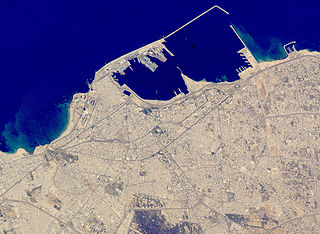
Tripoli is the capital and largest city of Libya, with a population of about 1.183 million people in 2023. It is located in the northwest of Libya on the edge of the desert, on a point of rocky land projecting into the Mediterranean Sea and forming a bay. It includes the port of Tripoli and the country's largest commercial and manufacturing center. It is also the site of the University of Tripoli. The vast Bab al-Azizia barracks, which includes the former family estate of Muammar Gaddafi, is also located in the city. Colonel Gaddafi largely ruled the country from his residence in this barracks.

Tripoli International Airport is a closed international airport built to serve Tripoli, the capital city of Libya. The airport is located in the area of Qasr bin Ghashir, 24 kilometres (15 mi) from central Tripoli. It used to be the hub for Libyan Airlines, Afriqiyah Airways, and Buraq Air.

The Tripoli protests and clashes were a series of confrontations between Libyan anti-government demonstrators and forces loyal to Libyan leader Muammar Gaddafi in the capital city of Tripoli that took place in February 2011, at the beginning of the Libyan civil war. During the early days of the uprising, there was significant unrest in the city, but the city remained under the control of the government.

The Tripoli Revolutionaries Brigade or Free Tripoli Guardian was a unit of the National Liberation Army of Libya created during the Libyan Civil War that merged into the Tripoli Protection Force. Originally formed in April 2011 in the opposition stronghold of Benghazi, it later relocated to the Nafusa Mountains, then the closest frontline to Tripoli, before advancing into the city itself in August.

The Battle of Tripoli, sometimes referred to as the Fall of Tripoli, was a military confrontation in Tripoli, Libya, between loyalists of Muammar Gaddafi, the longtime leader of Libya, and the National Transitional Council, which was attempting to overthrow Gaddafi and take control of the capital. The battle began on 20 August 2011, six months after the First Libyan Civil War started, with an uprising within the city; rebel forces outside the city planned an offensive to link up with elements within Tripoli, and eventually take control of the nation's capital.

Major General Osama al-Juwaili is a Libyan military officer who served as Minister of Defence in the government of Abdurrahim El-Keib, Libya's interim Prime Minister. Since the formation of the Government of National Accord (GNA) in 2015, al-Juwaili served it as a senior commander, since 2017 being the commander of the Western Military Zone. On 6 April 2019 he became the commander of the joint operations room, created by Prime Minister Fayez al-Sarraj to coordinate military operations since the start of the 2019 Western Libya offensive.

Following the end of the First Libyan Civil War, which overthrew Muammar Gaddafi, there was violence involving various militias and the new state security forces. This violence has escalated into the Second Libyan Civil War (2014–2020).

The Libyan Army is the brand for a number of separate military forces in Libya, which were under the command of the internationally recognised Government of National Accord (GNA) and the Government of National Unity.

Gaddafi loyalism, in a wider political and social sense also known as Green resistance or Tahloob, consists of sympathetic sentiment towards the overthrown government of Muammar Gaddafi, who was killed in October 2011, and his Third International Theory. Despite Muammar Gaddafi's death, his legacy and Jamahiriya ideology still maintains a popular appeal both inside and outside Libya into the present day. Regardless, the Western sentiment has largely been that this continued support may contribute to some of the ongoing violence in Libya.

The Libyan civil war (2014–2020), also more commonly known as the Second Libyan Civil War, was a multilateral civil war which was fought in Libya between a number of armed groups, but mainly the House of Representatives (HoR) and the Government of National Accord, for six years from 2014 to 2020.

The Libya Shield Force is an armed organisation formed in 2012 out of anti-Gaddafi armed groups spread throughout Libya. The Libyan parliament designated much of the Libya Shield Force as terrorist and elements of the Libya Shield Force were identified as linked to al-Qaeda as early as 2012.

The National Salvation Government was a government body formed by politicians from the General National Congress's blocs that lost the June 2014 elections in Libya. The NSG was led by Khalifa al-Ghawil. The term Libya Dawn Coalition was used to refer to the armed groups and the wider political movement supporting the NSG. The NSG was one of the major sides in the Second Libyan Civil War from its formation August 2014 until its dissolution in April 2016.
The following lists events that happened in 2014 in Libya.

The Libyan Crisis is the current humanitarian crisis and political-military instability occurring in Libya, beginning with the Arab Spring protests of 2011, which led to two civil wars, foreign military intervention, and the ousting and death of Muammar Gaddafi. The first civil war's aftermath and proliferation of armed groups led to violence and instability across the country, which erupted into renewed civil war in 2014. The second war lasted until October 23, 2020, when all parties agreed to a permanent ceasefire and negotiations.
Khalifa al-Ghawil, sometimes transliterated as Khalifa al-Ghweil or Ghwell, is a Libyan politician. He was the prime minister of the General National Congress-led National Salvation Government in Tripoli.
This is a detailed timeline of the Libyan civil war (2014–2020) which lasted from 2014 to 2020.
Clashes occurred in western Libya since 14 October 2016, when a coup d'état attempt was conducted by the former head of the National Salvation Government (GNS), Khalifa al-Ghawil, against Prime Minister Fayez al-Sarraj, the head of Libya's Government of National Accord (GNA). This evolved into fighting between the GNA and GNS for control of Tripoli and parts of western Libya, while pro-GNA militias also attacked other militias for control of the region.

The Battle of Tripoli was a series of clashes in Tripoli, Libya from 27 August to 25 September 2018 during the Second Libyan Civil War. It was fought between several militias and was ended by a ceasefire.

The Western Libya campaign was a military campaign initiated on 4 April 2019 by the Operation Flood of Dignity of the Libyan National Army, which represents the Libyan House of Representatives, to capture the western region of Libya and eventually the capital Tripoli held by the United Nations Security Council-recognised Government of National Accord. The Government of National Accord regained control over all of Tripoli in June 2020 and the LNA forces withdrew from the capital, after fourteen months of fighting.
This is the order of battle for the Western Libya campaign, codenamed "Operation Flood of Dignity" by forces under Field Marshal Khalifa Haftar. The forces supporting Haftar and the House of Representatives, mainly the Libyan National Army, are opposed by the armed forces of the forces loyal to the Government of National Accord, including the Libyan Army and the Tripoli Protection Force.














